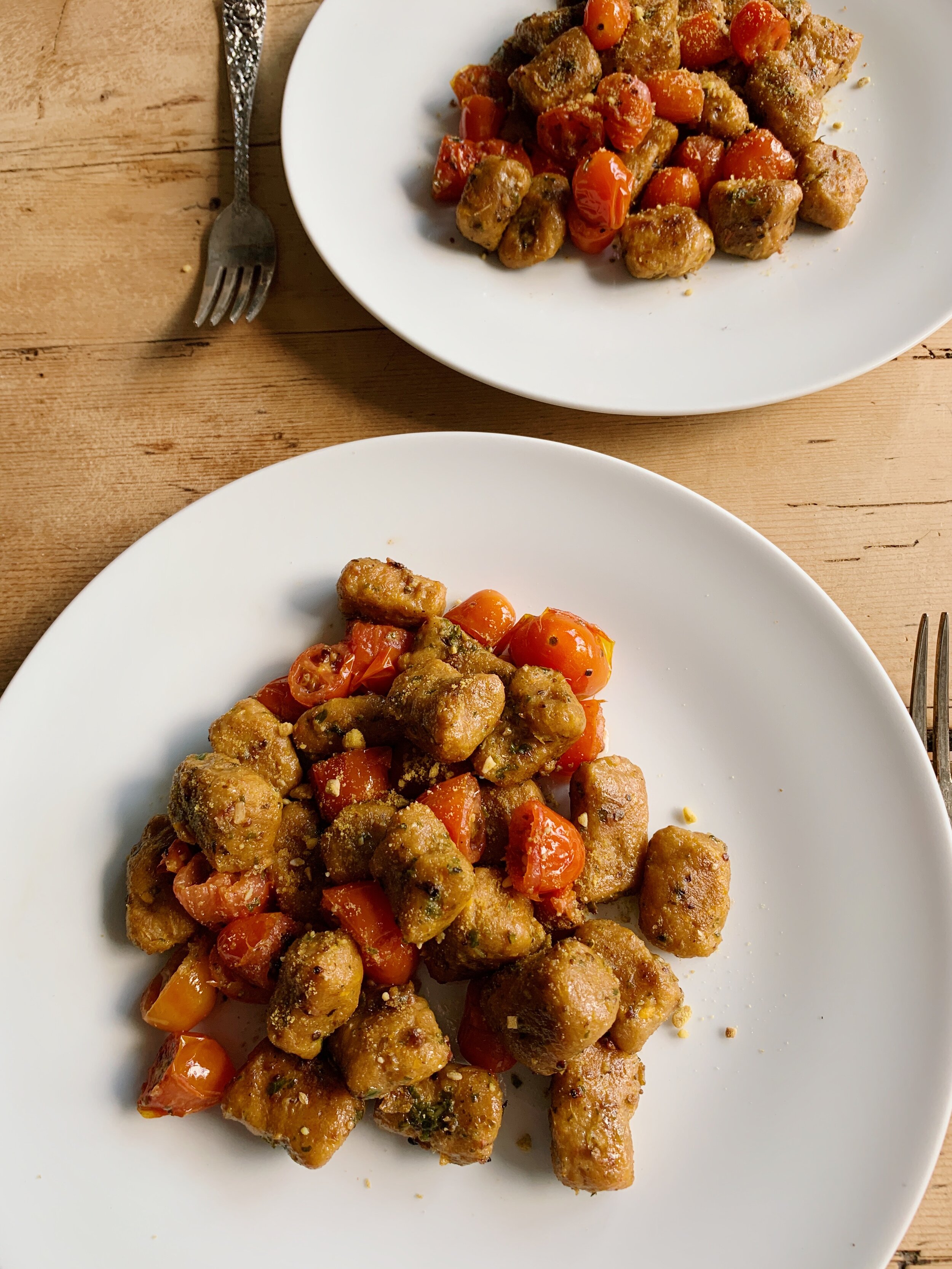Back to My Roots: Plant-Based Italian Pasta Dishes
As a child, I loved being in the kitchen near dinner time, watching a big steam cloud emerge from the sink as my mom poured a hot pot of pasta into a colander. My eyes followed as she transferred the drained pasta into a pan, mixing it with other ingredients-- sometimes a simple tomato sauce, other times cheese and eggplant, pesto, or plain butter. Being Italian via my father’s family, pasta was a weeknight staple at home, and boxes of various shapes, from penne to capellini, lined the cabinets. I was instructed at a young age not to break spaghetti before placing it into boiling water, and to twirl it on my fork patiently until it became a firm knot. The most exciting meals were when we went to my grandparents home for lunch or dinner-- my mom and I would frequently discuss the delicate spinach-ricotta ravioli with giddy anticipation.
As I got older and became a teenager, I started to go to restaurants with friends and gravitated toward ordering pasta. I discovered a new found love for cacio e pepe, a simple Roman pasta dish made with parmesan and fresh black pepper that was silky and retained a decadent, cheesy flavor in each bite. After high school, I spent a gap year in Israel, and my diet shifted: not only was I eating middle eastern dishes like falafel and hummus on a daily basis, but I had decided to become plant-based along with some friends after learning about the environmental issues around the meat and dairy industries. There was a lot of time to practice and develop my cooking skills in Israel-- while having to make dinner for others on my program and visiting friends’ families on weekends and watching what they prepared. Yet I was mostly focusing on vegetable-centered dishes like whole roasted cauliflower, eggplant, and salads and rarely ate pasta. It was only last year in quarantine that I realized I could return to making my childhood comfort food.
Like others at the start of the pandemic, I was transported back to living with family and had more time to think about childhood memories. I decided I wanted to return to the fundamentals of Italian cooking, creating a punchy and decadent flavor without the dairy, eggs or meat. In order to do this, I turned to some underrated tricks and ingredients that greatly enhance the taste, texture and composition of a dish.
Always cook your pasta short of al dente, so that it then becomes al dente when cooking/mixing it with the sauce.
Leave some starchy pasta water in a cup on the side, and use a little bit of it to make the sauce and when mixing the pasta with the sauce. This creates a silky, not-dry texture and taste and allows the sauce to stick to the pasta correctly.
Use Nutritional Yeast: this is a plant based cook’s favorite ingredient. It has a cheesy flavor, thickens sauces, and is a great parmesan replacement in homemade pesto.
Use tomato paste in tomato-based sauces: whether it is pomodoro, vodka, or a (mushroom) ragu, tomato paste provides thickness and sweetness to a sauce, holding the dish together.
Use fresh herbs: I always have fresh basil on hand and place generous amounts of it in sauces, especially tomato-based ones.
Over quarantine, I developed several pasta recipes that I prepared for myself and my family. While I started with a mindset to ‘replace’ certain key ingredients since I lacked animal products, I began to appreciate the minimal approach of plant-based cooking. I realized I was actually starting from the ground up, creating dishes with only a core set of fresh ingredients-- it doesn’t take much to prepare a good pasta. I also began playing with ingredients and making new versions of classics-- for example, a sweet potato-spelt flour gnocchi, with a stronger flavor than the more muted classic. I now rely on some of these recipes on a regular basis for weeknight meals.
Here are Three Plant-based recipes I developed throughout the past year:
Gnocchi made from Sweet Potato and Spelt Flour:
2 large sweet potatoes (or 3 medium sweet potatoes)
2.5 - 3 cups spelt our
2 tbsp nutritional yeast for taste 3 tbsp olive oil
Salt & fresh basil to taste (can sub fresh rosemary)
Directions:
1. Place ingredients into a bowl and mix until dough forms. Knead the dough into a ball and dip hands in water so that the dough doesn’t stick to your hands too much. Add extra our as needed. Let sit for around 15-20 minutes.
2. Divide dough into four sections. Roll each section into strips one at a time, cutting them into small pieces. Make sure to add extra flour to the surface you are cutting on, and sprinkle our onto the gnocchi.
3. Bring a pot of water to boil. Once bubbles form, add salt to water. Place gnocchi into the pot and cook until they float to the top.
4. Place into a pan with olive oil and garlic for crispy edges.
Fresh Pesto Pasta:
Cooked pasta of choice
3 handfuls fresh basil leaves
1 handful greens (spinach or kale)
1 handful of pine nuts
(Optional: extra handful of cashews or walnuts)
2-3 cloves garlic chopped
⅛- ¼ cup olive oil
Sea salt & juice from half a lemon 2 tbsp nutritional yeast for taste
Directions:
1. Cook pasta in salted water, leaving aside a small cup of starchy pasta water.
2. In a bowl, mix ingredients listed above. Begin with the basil and greens, add in the squeezes of lemon, salt, oil. Chop garlic finely until it becomes pasty, chop the pine nuts and then bring it all together, adding nutritional yeast. Can also use a food processor.
3. When everything is mixed evenly, place 1-2 tbsp starchy pasta water to make the pesto more fluffy/ smooth.
4. Pour the pesto onto the cooked pasta and mix together on a low ame.
5. Optional: serve with crispy roasted brussel sprouts, any other vegetable, or pan toasted pine nuts on top for extra avor.
A’ La Vodka:
Cooked Pasta
(Penne, Rigatone, or any fun shape)
Olive oil, Salt
1 small can tomato paste
1 can whole peeled tomatoes chopped 2-3 cloves garlic chopped
1 onion chopped
Handful of fresh basil leaves
1/3 cup almond or oat milk
1/4 cup vodka
1/4-1/3 cup nutritional yeast
Optional: greens
Directions:
1. Cook pasta in salted water and save a cup of the starchy pasta water.
2. In a pan, place olive oil at high heat. When hot, add garlic, onion, chopped basil, and salt. Cook on medium heat.
3. Add in tomato paste and chopped whole peeled tomatoes along with half of the nutritional yeast and stir.
4. Add splashes of milk and continue stirring, increasing the heat to absorb excess liquid. Add in vodka and continue stirring. Add some more nutritional yeast. When it becomes a thick dark orange / light red sauce with no excess liq- uid, add a handful of greens if desired.
5. Add the cooked pasta with a few splashes of pasta water and a tiny bit of nutri- tional yeast, increasing the heat to high in order to absorb the liquid. Lower the ame, stir, and serve with fresh basil on top.



